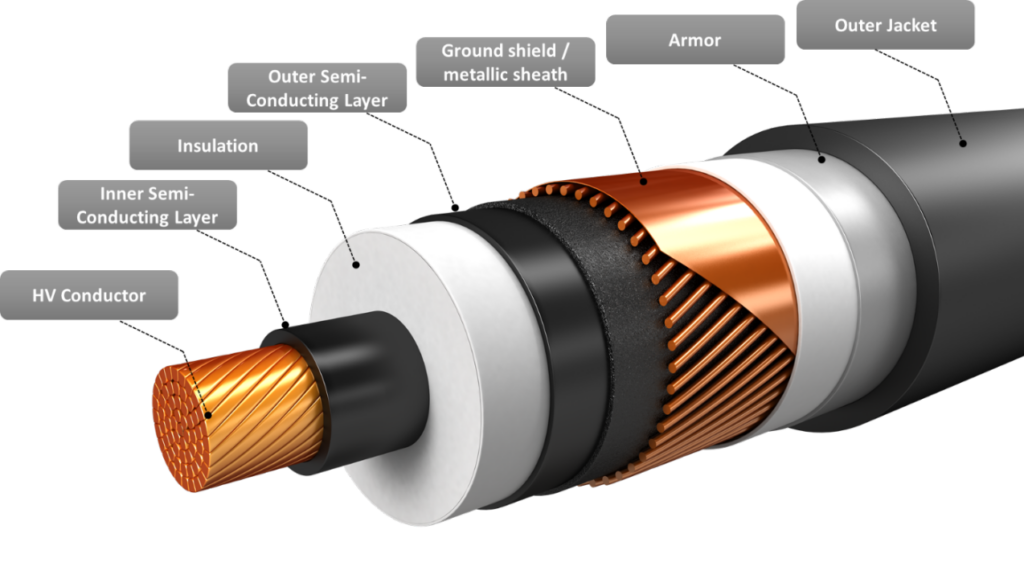
- Usage Scenarios, How It Works, Features, and Drawbacks
Medium voltage power cables are the unsung heroes of the electrical world, bridging the gap between low voltage distribution and high voltage transmission. They ensure that electricity is efficiently transmitted over medium distances, making them indispensable in various settings.
Usage Scenarios:
- Industrial Plants: Powering machinery and equipment in factories.
- Commercial Buildings: Ensuring reliable power in large office complexes and shopping centers.
- Infrastructure Projects: Used in airports, railway stations, and hospitals.
How It Works:
Medium voltage power cables transport electricity typically ranging from 1kV to 35kV. They consist of a conductor, insulation, and protective layers to ensure efficient and safe power transmission.
Features:
- High Efficiency: Designed for minimal power loss over medium distances.
- Safety: Insulated to prevent electrical hazards.
- Durability: Resistant to environmental factors and mechanical stress.
Drawbacks:
- Cost: More expensive than low voltage cables.
- Complex Installation: Requires skilled labor and specialized equipment for installation.
Insert Image: Diagram showing medium voltage power cable in an industrial setting.
- Classification by Material, Function, and Standards
By Material:
- Copper Conductor: Offers superior conductivity and durability.
- Aluminum Conductor: Lightweight and cost-effective, though less conductive.
By Function:
- Power Distribution: Main cables for delivering medium voltage electricity.
- Control Cables: Used for monitoring and controlling electrical systems.
- Instrumentation Cables: Transmit signals and data in complex control systems.
By Standards:
- IEC (International Electrotechnical Commission): Global safety and performance standards.
- IEEE (Institute of Electrical and Electronics Engineers): Widely used in North America.
- BS (British Standards): Common in the UK and many other countries.
Insert Image: Different types of medium voltage power cables categorized by material and function.
- Product Structure and Specifications
Medium voltage power cables consist of the following layers:
- Conductor: The core, typically made of copper or aluminum.
- Conductor Shield: A semi-conducting layer to distribute electric stress.
- Insulation: Often made of XLPE (cross-linked polyethylene) for high voltage endurance.
- Insulation Shield: Another semi-conducting layer.
- Metallic Shield: Provides a path for fault currents and protects the cable.
- Sheath: An outer protective layer, usually PVC or PE.
Popular Models:
- MV-10kV Cable: Suitable for medium-sized industrial plants, with conductor cross-sections ranging from 50-500 mm².
- MV-20kV Cable: Used in large commercial buildings, with conductor cross-sections ranging from 70-800 mm².
Insert Image: Cross-section diagram of a medium voltage power cable showing its layers.
- Production Process, Testing Methods, and Steps
Production Process:
- Wire Drawing: Reducing the diameter of the conductor wire.
- Stranding: Twisting multiple wires together for flexibility.
- Conductor Shielding: Applying the first semi-conducting layer.
- Insulation: Applying the insulating material.
- Insulation Shielding: Adding another semi-conducting layer.
- Metallic Shielding: Applying the metallic shield.
- Sheathing: Adding the outer protective layer.
Testing Methods:
- Electrical Testing: Ensuring proper conductivity and insulation resistance.
- Mechanical Testing: Checking the strength and flexibility of the cable.
- Environmental Testing: Simulating extreme conditions to ensure durability.
Insert Image: Production line of medium voltage power cables with labeled stages.
- New Products, Technologies, and Innovations
New Products:
- Enhanced XLPE Cables: Improved insulation materials for better performance and longevity.
- High Temperature Cables: Designed to operate at higher temperatures, offering more flexibility in installation environments.
New Technologies:
- Smart Cables: Integrated sensors for real-time monitoring of cable conditions and performance.
- Improved Shielding Materials: Better protection against electrical interference and environmental factors.
Insert Image: New generation medium voltage power cables with innovative features.
- Relevant Links for Further Information
- IEC Standards on Medium Voltage Power Cables
- IEEE Guidelines for Medium Voltage Cables
- [Medium Voltage Cable Product Specifications](https://www.example.com/medium-voltage-cable-specs
